|
Have a safe day!
Tuesday, Feb. 24
3:30 p.m.
Director's Coffee Break - WH2XO
4 p.m.
Accelerator Physics and Technology Seminar - One West
Speaker: George Ginther, Fermilab
Title: Mu2e - A Search for Muon to Electron Conversion at Fermilab
Wednesday, Feb. 25
10 a.m.
All-Office-of-the-COO meeting - Auditorium
3:30 p.m.
Director's Coffee Break - WH2XO
THERE WILL BE NO FERMILAB COLLOQUIUM TODAY
Visit the labwide calendar to view Fermilab events
|
|
Tuesday, Feb. 24
- Breakfast: all-American breakfast
- Breakfast: bacon, egg and cheese bagel
- Chicken fajita sandwich
- Stir-fried pork and cabbage
- South American beef empanada
- Rachel melt
- Chicken carbonara
- Corn chowder
- Chef's choice soup
- Assorted pizza by the slice
Wilson Hall Cafe menu
|
|
Wednesday, Feb. 25
Lunch
- Vegetable stir fry
- Pineapple coconut banana upside-down cake
Friday, Feb. 27
Dinner
- Roasted butternut squash salad with sherry vinaigrette
- Lobster tail with lemon butter sauce
- Sauteed spinach
- Cauliflower puree
- Chocolate pot de creme with fresh berries
Chez Leon menu
Call x3524 to make your reservation.
|
|
Physics for the people
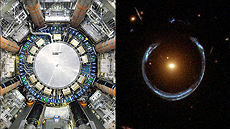 |
| Illustration: Manuel Gnida, SLAC / Images courtesy of CERN, ESA/Hubble and NASA |
Citizen science, scientific work done by the general public, is having a moment.
In June 2014, the term "citizen science" was added to the Oxford English Dictionary. This month, the American Association for the Advancement of Science — one of the world's largest general scientific societies — dedicated several sessions at its annual meeting to the topic. A two-day preconference organized by the year-old Citizen Science Association attracted an estimated 700 participants.
Citizen scientists interested in taking part in particle physics research have few options at the moment, but they may have a new opportunity on the horizon with the Large Synoptic Survey Telescope.
Hunting the Higgs
Citizen science projects have helped researchers predict the structure of proteins transcribe letters from Albert Einstein, and monitor populations of bees and invasive crabs. The citizen science portal "Zooniverse," launched in 2007, has attracted 1.3 million users from around the world. According to a report by Oxford University astronomer Brooke Simmons, the first Zooniverse project, "Galaxy Zoo," has so far published 57 scientific papers with the help of citizen scientists.
Of the 27 projects on the Zooniverse portal, just one allows volunteers to help with the analysis of real data from a particle physics experiment. "Higgs Hunters," launched in November 2014, invites citizen scientists to help physicists find evidence of strange particle behavior in images of collisions from the Large Hadron Collider.
When protons collide in the LHC, their energy transfers briefly into matter, forming different types of particles, which then decay into less massive particles and eventually dissipate back into energy. Some particle collisions create Higgs bosons, particles discovered in 2012 at the LHC.
Read more
—Manuel Gnida and Kathryn Jepsen
|
Scientists talk high-stakes science as part of Joint Speaker Series
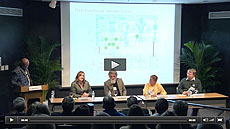 |
| Scientists from Argonne National Laboratory, Fermilab and the University of Chicago discuss the risks and rewards of participating in high-stakes science as part of the Joint Speaker Series. The program took place on Jan. 15 at Fermilab. Among the panelists was Richard Tesarek, NOvA deputy project manager. View video of the discussion. Video: University of Chicago |
|
Holdings patterns
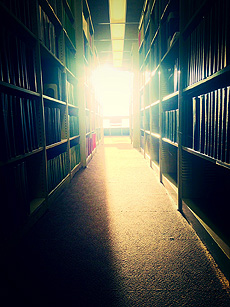 |
| Illuminated by sunlight, the library stacks provide a mesmerizing view. Photo: Stephanie Timpone |
 |
| Physics research comes in many colors. Photo: Stephanie Timpone |
|
Supermassive diet: Black holes bulk up on dark matter
From Discovery, Feb. 18, 2015
It has long been assumed that the size of a supermassive black hole in a galaxy's core is intimately related to the number of stars that galaxy contains — but it might not be that simple after all.
Every galaxy is cocooned inside a massive halo of dark matter, the invisible stuff that is thought to account for nearly 85 percent of all matter in the universe. The bigger the galaxy, the bigger the dark matter halo. The stars that we observe in any given galaxy accounts for a tiny fraction of the total mass of that galaxy — the halo can extend for hundreds of thousands of light years from the visible galaxy's "edge."
Read more
|
|
Deep science
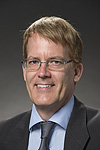 |
|
Joe Lykken
|
I clipped my harness to some webbing in the corner of the open work cage, and a few seconds later foreman George Vandine signaled the hoist operator to begin our descent of the Ross Shaft. Our headlamps barely penetrated the Stygian gloom, enough to see the brand new tubular steel frames and other modernizations that will provide high-speed access and utilities to the Ross Campus, almost a mile underground. The inspection tour halted more than 2,000 feet down, where the new steel gave way to an 80-year-old rusted skeleton, left over from the Homestake mine. Mike Headley, the executive director of the South Dakota Science and Technology Authority, summed up their progress: "The rehab is almost half done, and it's going smoothly with two 12-hour shifts a day. We'll be ready for LBNF construction in 2017."
Earlier that day, Mike had led Tim Meyer and me on an impressive tour of the 4,850-foot level of the Sanford Underground Research Facility. Emerging from the Yates Shaft we found a tidy intersection of drifts (a drift is what miners call a tunnel that doesn't connect to the surface) with overhead utilities and a cute little rail system. After two stages of cleanup (even my phone got a wipe) we were allowed into the lab area of the Davis Campus.
I might just as well have been back at Fermilab, instead of a mile underground. There was an espresso machine and wireless. We got a peek into the ultraclean room where the Majorana Demonstrator is being assembled, and then Rick Gaitskell greeted us in the Davis Cavern, the site of Ray Davis' visionary (and Nobel-worthy) discovery of neutrino oscillations. Today this cavern is a cutting-edge lab housing LUX, the world-leading dark matter detection experiment, and is soon to be the home of LZ, the next-generation experiment that Fermilab is collaborating on.
From there it was a substantial hike in my rubber boots to the Ross Campus, where SDSTA engineer Josh Willhite showed us the site reserved for the LBNF caverns. Once the rehab of the Ross Shaft is complete, they can extract 1,500 tons of rock per day, whisked to the surface in skips that will go from bottom to top in three minutes flat. Josh waved his arm at a slight angle to the drift: "The caverns will go that way, pointing towards Fermilab."
After our underground sojourn, Tim and I met Mike, Josh and DOE operations managers Kevin Lesko and Gil Gilchriese at the Deadwood Social Club. Raising a glass each of Pile O'Dirt, the local microbrew, we made a toast: "Here's to LBNF construction in 2017."
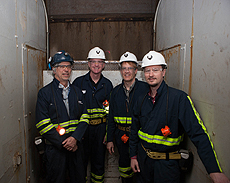 |
| DOE Operations Manager Kevin Lesko, South Dakota Science and Technology Authority Executive Director Mike Headley, Fermilab Deputy Director Joe Lykken and Fermilab Chief Operating Officer Tim Meyer descend 4,850 feet underground through the Yates shaft at the Sanford Underground Research Facility. Photo: Matt Kapust, South Dakota Science and Technology Authority |
|
High stakes science pays off
From UChicago News, Feb. 13, 2015
Whether caring for Ebola patients, chasing neutrinos deep underground, synthesizing the poliovirus or downgrading weapon-grade uranium, scientists often face high stakes. Yet, despite the risks, they keep working for the greater good.
"At first we didn't know what to expect, but we decided the risk was worth taking," said Cynthia Boggs, program manager of the 20-year Highly Enriched Uranium Transparency Program under the National Nuclear Security Administration. Boggs is also an engineer at Argonne National Laboratory, and was a panelist at "High Stakes Science: Pushing the Boundaries," the 10th in a series of Joint Speaker events for faculty, researchers and engineers at the University of Chicago, Argonne and Fermi National Accelerator Laboratory.
Read more
|
|